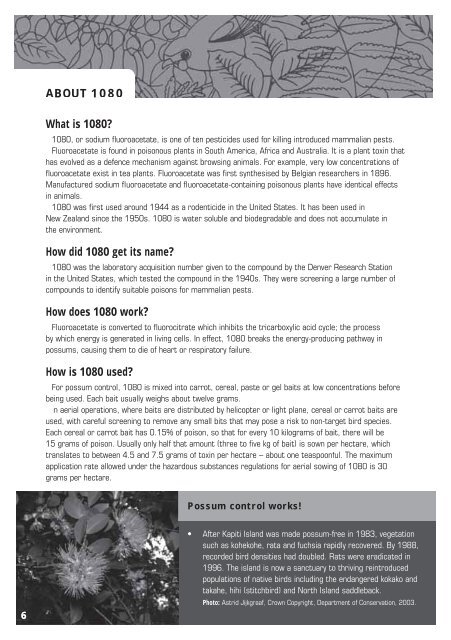National Possum Control Agencies - Department of Conservation
National Possum Control Agencies - Department of Conservation
National Possum Control Agencies - Department of Conservation
Create successful ePaper yourself
Turn your PDF publications into a flip-book with our unique Google optimized e-Paper software.
6<br />
ABOUT 1080<br />
What is 1080?<br />
1080, or sodium fl uoroacetate, is one <strong>of</strong> ten pesticides used for killing introduced mammalian pests.<br />
Fluoroacetate is found in poisonous plants in South America, Africa and Australia. It is a plant toxin that<br />
has evolved as a defence mechanism against browsing animals. For example, very low concentrations <strong>of</strong><br />
fl uoroacetate exist in tea plants. Fluoroacetate was fi rst synthesised by Belgian researchers in 1896.<br />
Manufactured sodium fl uoroacetate and fl uoroacetate-containing poisonous plants have identical effects<br />
in animals.<br />
1080 was fi rst used around 1944 as a rodenticide in the United States. It has been used in<br />
New Zealand since the 1950s. 1080 is water soluble and biodegradable and does not accumulate in<br />
the environment.<br />
How did 1080 get its name?<br />
1080 was the laboratory acquisition number given to the compound by the Denver Research Station<br />
in the United States, which tested the compound in the 1940s. They were screening a large number <strong>of</strong><br />
compounds to identify suitable poisons for mammalian pests.<br />
How does 1080 work?<br />
Fluoroacetate is converted to fl uorocitrate which inhibits the tricarboxylic acid cycle; the process<br />
by which energy is generated in living cells. In effect, 1080 breaks the energy-producing pathway in<br />
possums, causing them to die <strong>of</strong> heart or respiratory failure.<br />
How is 1080 used?<br />
For possum control, 1080 is mixed into carrot, cereal, paste or gel baits at low concentrations before<br />
being used. Each bait usually weighs about twelve grams.<br />
In aerial operations, where baits are distributed by helicopter or light plane, cereal or carrot baits are<br />
used, with careful screening to remove any small bits that may pose a risk to non-target bird species.<br />
Each cereal or carrot bait has 0.15% <strong>of</strong> poison, so that for every 10 kilograms <strong>of</strong> bait, there will be<br />
15 grams <strong>of</strong> poison. Usually only half that amount (three to fi ve kg <strong>of</strong> bait) is sown per hectare, which<br />
translates to between 4.5 and 7.5 grams <strong>of</strong> toxin per hectare – about one teaspoonful. The maximum<br />
application rate allowed under the hazardous substances regulations for aerial sowing <strong>of</strong> 1080 is 30<br />
grams per hectare.<br />
<strong>Possum</strong> control works!<br />
• After Kapiti Island was made possum-free in 1983, vegetation<br />
such as kohekohe, rata and fuchsia rapidly recovered. By 1988,<br />
recorded bird densities had doubled. Rats were eradicated in<br />
1996. The island is now a sanctuary to thriving reintroduced<br />
populations <strong>of</strong> native birds including the endangered kokako and<br />
takahe, hihi (stitchbird) and North Island saddleback.<br />
Photo: Astrid Jijkgraaf, Crown Copyright, <strong>Department</strong> <strong>of</strong> <strong>Conservation</strong>, 2003.

















